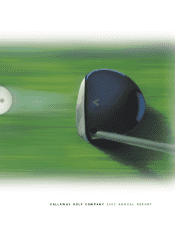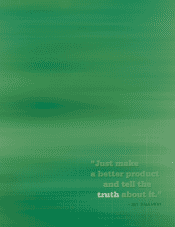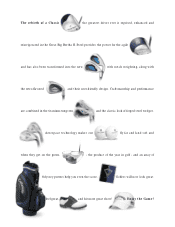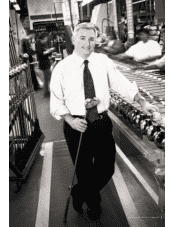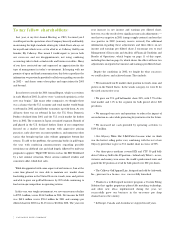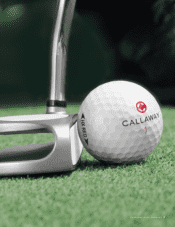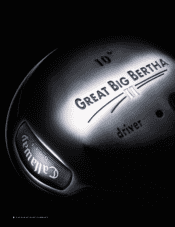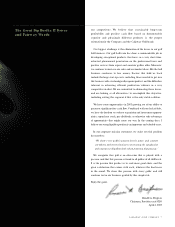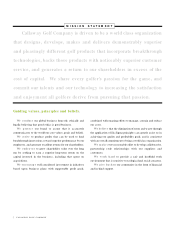Callaway 2002 Annual Report Download - page 5
Download and view the complete annual report
Please find page 5 of the 2002 Callaway annual report below. You can navigate through the pages in the report by either clicking on the pages listed below, or by using the keyword search tool below to find specific information within the annual report.
Last year, at my first Annual Meeting as CEO, I assured you I
would report on the operations of our Company honestly and frankly,
maintaining the high standards of integrity which I have always set
for myself and which were set for all of us at Callaway Golf by our
founder, Ely Callaway. This meant I would report to you on both
our successes and our disappointments, not using confusing
accounting rules to hide actual results and business realities. Many
of you have contacted me and expressed an appreciation for this
type of management in today’s environment. In keeping with my
promise of open and frank communication, this letter capsulizes the
information we previously provided to all of you regarding our results
in 2002 – and shares some of our plans and expectations for 2003
and beyond.
In my letter to you for the 2001 Annual Report, which was written
in early March of 2002, I said we were “cautiously optimistic as the
new year begins.” Like many other companies, we thought there
was a chance that the U.S. economy and stock market would begin
to rebound in 2002 and pull other economies up with them. As you
all know, there was no rebound. In fact, the U.S. Gross Domestic
Product declined from 2001 and the U.S. stock market hit further
lows in 2002. The economy in Japan remained stagnant. Rounds of
golf played in the U.S. declined further. Some of our competitors
focused on a market share strategy with aggressive pricing
practices, early close-outs on current products, and numerous other
tactics that brought top line sales without appropriate bottom line
returns. To add to the problems, the governing bodies in golf began
the year with confusing announcements regarding possible
restrictions on clubhead size and shaft length, followed by mid-year
proposals to approve “High COR” drivers such as the ERC II, followed
by a late summer retraction. These actions confused retailers and
consumers alike, which hurt sales.
While disappointed with some aspects of our business, I am at the
same time pleased we were able to maintain our market share
leadership position in the United States in woods, irons and putters
and able to grow our golf ball business by 20% while continuing to
lead our major competitors in operating returns.
In this very, very tough environment, we saw our revenues decline
to $792.1 million, versus $816.2 million in 2001. Net income for 2002
was $69.4 million versus $58.4 million for 2001 and earnings per
diluted share for 2002 was $1.03 versus $0.82 for 2001. The year over
year increase in net income and earnings per diluted share,
however, was the result of two significant non-cash adjustments —
one that was negative in 2001 (energy supply contract) and one that
was positive in 2002 (warranty reserve reversal). For additional
information regarding these adjustments and their effects on net
income and earnings per diluted share, I encourage you to read
Management’s Discussion and Analysis of Financial Condition and
Results of Operations, which begins on page 11 of this report,
including the chart on page 16, which shows the effects of these two
adjustments on reported net income and earnings per diluted share.
Despite the conditions in 2002, we fought for what successes
we could achieve; and achieved many. They include:
• We maintained our #1 market share position in woods, irons and
putters in the United States. In the woods category, we were #1 for
the sixth consecutive year.
•We grew our U.S. golf ball market share 20%, with 5.7% of the
total market and 11% in the segment for balls priced above $20
per dozen.
•We managed our costs and operations to reduce the impact of
our reduction in sales while protecting key initiatives for the future.
•We increased net cash provided by operating activities to
$139.2 million.
•Our Odyssey White Hot 2-Ball Putter became what we think
was the hottest selling putter ever, combining with the rest of our
Odyssey putter line to give us U.S. market share in excess of 50%.
• Our three-piece urethane covered HX and CTU 30 golf balls
drove Callaway Golf to the #2 position – behind only Titleist – in use,
victories and money won across the world’s professional tours and
gained the #2 position at retail for balls priced over $20 per dozen.
•The Callaway Golf Apparel Line, designed and sold by Ashworth,
Inc., pursuant to a license, was successfully launched.
•Thanks to a well designed incentive program, a Custom Fitting
Solution that applies proprietary player/club matching technology,
and other new ideas implemented during the year, we
successfully grew our business in the on-course pro shop
channel across the country.
•In Europe, Canada and Australia we enjoyed record years.
To m y fe llow s hareholders :
2 CALLAWAY GOLF COMPANY

